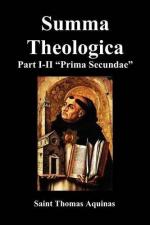Now of all the gifts which God vouchsafed to mankind after they had fallen away by sin, the chief is that He gave His Son; wherefore it is written (John 3:16): “God so loved the world, as to give His only-begotten Son; that whosoever believeth in Him, may not perish, but may have life everlasting.” Consequently the chief sacrifice is that whereby Christ Himself “delivered Himself . . . to God for an odor of sweetness” (Eph. 5:2). And for this reason all the other sacrifices of the Old Law were offered up in order to foreshadow this one individual and paramount sacrifice—the imperfect forecasting the perfect. Hence the Apostle says (Heb. 10:11) that the priest of the Old Law “often” offered “the same sacrifices, which can never take away sins: but” Christ offered “one sacrifice for sins, for ever.” And since the reason of the figure is taken from that which the figure represents, therefore the reasons of the figurative sacrifices of the Old Law should be taken from the true sacrifice of Christ.
Reply Obj. 1: God did not wish these sacrifices to be offered to Him on account of the things themselves that were offered, as though He stood in need of them: wherefore it is written (Isa. 1:11): “I desire not holocausts of rams, and fat of fatlings, and blood of calves and lambs and buckgoats.” But, as stated above, He wished them to be offered to Him, in order to prevent idolatry; in order to signify the right ordering of man’s mind to God; and in order to represent the mystery of the Redemption of man by Christ.
Reply Obj. 2: In all the respects mentioned above (ad 1), there was a suitable reason for these animals, rather than others, being offered in sacrifice to God. First, in order to prevent idolatry. Because idolaters offered all other animals to their gods, or made use of them in their sorceries: while the Egyptians (among whom the people had been dwelling) considered it abominable to slay these animals, wherefore they used not to offer them in sacrifice to their gods. Hence it is written (Ex. 8:26): “We shall sacrifice the abominations of the Egyptians to the Lord our God.” For they worshipped the sheep; they reverenced the ram (because demons appeared under the form thereof); while they employed oxen for agriculture, which was reckoned by them as something sacred.
Secondly, this was suitable for the aforesaid right ordering of man’s mind to God: and in two ways. First, because it is chiefly by means of these animals that human life is sustained: and moreover they are most clean, and partake of a most clean food: whereas other animals are either wild, and not deputed to ordinary use among men: or, if they be tame, they have unclean food, as pigs and geese: and nothing but what is clean should be offered to God. These birds especially were offered in sacrifice because there were plenty of them in the land of promise. Secondly, because the sacrificing of these animals represented purity of heart. Because as the gloss says on Lev. 1, “We offer a calf, when we overcome the pride of the flesh; a lamb, when we restrain our unreasonable motions; a goat, when we conquer wantonness; a turtledove, when we keep chaste; unleavened bread, when we feast on the unleavened bread of sincerity.” And it is evident that the dove denotes charity and simplicity of heart.




